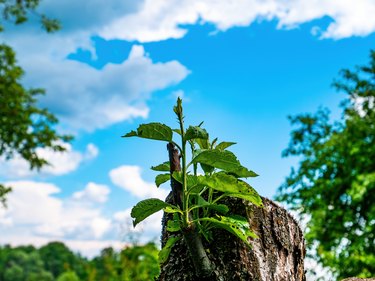
Trees are tenacious. Like most living things, they seem to have a survival instinct of sorts and will try to grow back after you cut them down. This is a problem if you want the tree to stay gone and its root system to break down.
In many cases, stump grinding and other stump removal methods can work, but they are labor-intensive and not always feasible A stump grinder, for instance, won't work well on uneven ground or on stumps close to structures. In these cases, painting the stump is best.
Video of the Day
Video of the Day
Stump Painting Clarification
The term "stump painting" can prove somewhat confusing to those outside of landscaping, logging, and related industries. Painting a stump does not refer to applying actual paint but instead means applying an herbicide to the stump. These herbicides are sometimes mixed with a bit of dye or latex paint but only because doing so makes it easy to visually verify that the entire surface of the stump was treated.
If you have some paint left over from a home improvement project, don't assume that coating an unwanted tree stump with it will solve your problem. It probably won't as evidenced by the fact that orchard owners whitewash tree trunks often to prevent sunburn and insect infestations. They clearly would not do this if the paint killed the tree.
Things You'll Need
Long-sleeve shirt
Plastic bucket
Soap
How to Paint to Stop Stump Growth
Step 1: Prepare the Stump
Ideally, the best time to paint the tree stump is immediately after cutting down the tree. As you've likely noticed, cut flowers and Christmas trees both absorb much more water when they're fresh. This principle also applies when painting stumps. You want to apply the herbicide while the cut is fresh and still rapidly soaking up liquids, preferably within five minutes of cutting down the tree. If it's been a while since you cut down the tree, you'll want to refresh the stump if you can.
- Cut the tree stump down further with a chainsaw, cutting deeply enough that you reach live wood if you can. If the stump is too close to the ground for this or if you've just cut down the tree, you can skip this step.
- Prune away any new sprouts growing from the stump if you can't cut the stump itself. Again, you can skip this step if you've just cut down the tree.
Warning
Remember to wear safety goggles when working with a chainsaw.
Step 2: Prepare the Herbicide
Rainwater can easily wash away freshly applied herbicides, so make checking the weather part of your stump painting preparations. If rain is expected in the next four to six hours, leave your stump painting for another day. This will make your application more effective and help prevent it from simply running off and possibly ending up where it shouldn't. If clear skies are predicted, go ahead and prepare your herbicide.
- Put on a pair of vinyl gloves and safety goggles before you begin working with herbicide. You should also put on a long-sleeve shirt to protect your skin. Avoid wearing leather gloves or shoes, as these absorb liquid herbicides.
- Dilute a liquid herbicide containing glyphosate in a bucket or small container as directed on the label. Some herbicides require dilution, while others come ready to use. Always follow the directions on the product label. A 20 percent glyphosate solution generally doesn't require dilution. Solutions of 41 percent or higher, however, need to be mixed with water at a 50-50 ratio.
Step 3: Paint the Stump
When your preparations are finished, grab a paintbrush and head out to paint your unwanted stump. If you notice any dirt on top of the stump, wipe it away with your hand before painting. You want the herbicide to have direct contact with the wood.
- Paint the herbicide mixture onto the top of the tree stump with your paintbrush. Make sure you cover the entire stump, especially around the edges just inside the tree bark. This is the portion of the tree that will transfer the herbicide to the roots most effectively, helping to kill the stump from below.
- Store any unused herbicide mixture as instructed on the product label in a place where children and pets can't access it. Wash your paintbrush thoroughly with soap and water or dispose of it safely.
- Repaint the tree stump in two to four weeks if it is still alive. One application of herbicide will often do the trick, especially if it's applied immediately after cutting down the tree. If needed, however, you can paint the stump again. You can paint the stump at any time during the year, but fall is generally the most effective time.